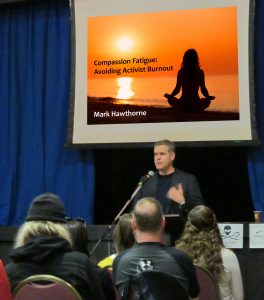A Mark Hawthorne Ethic

Photo by Tara Baxter
Mark Hawthorne, author of Striking at the Roots and Bleating Hearts, is one of the movement’s best and most prolific writers. We last talked to Mark on the occasion of Bleating Hearts, and caught up with him again regarding his latest book A Vegan Ethic: Embracing a Life of Compassion Toward All.
Mark is also one of the smartest humans I know, and his new book proves it. Even longtime vegans will benefit from exploring the topics in A Vegan Ethic. And yes, I know I said that about Bleating Hearts too. (Consistency is a virtue.)
We sat down to talk about the new book and some of the issues it raises.
Intersectionality is a growing buzzword amongst the animal rights community. Can you describe what intersectionality is, and do you see this movement as a positive or negative for the animal rights community? There has been pushback from some activists who feel that animal rights is such a small movement to begin with and that we should keep our focus on the animals, or that it places more emphasis on human oppression than animal oppression.
The term “intersectionality” was coined in 1989 by Dr. Kimberle Crenshaw as a way to describe the way Black women experience multiple oppressions, and so it has a very specific definition for a very specific group. Unfortunately, some people in the AR movement have appropriated the term and applied it very loosely to mean the various ways that speciesism can be connected to racism, sexism, homo-aggression, classism, ableism, sizeism, and so on.
I see the value in having a more holistic approach to animal rights—indeed, that’s the point of A Vegan Ethic—but I think we need to be very careful to not alienate other groups and movements as we do this. Black people, for instance, have long been called “animals,” “monkeys,” “beasts,” and other dehumanizing names, and we need to be sensitive to their experience and recognize that for many of them, the idea of “animal rights” might be fraught with issues. How can we expect them to feel safe in animal rights spaces when they themselves are often not considered human?
In this book I argue that being inclusive in our compassion is the only course for us to take if we want to free nonhuman animals from exploitation—that victory for the animal liberation movement will only come through working for liberation for all marginalized groups.
And, yes, not everyone in the AR movement likes the idea of giving other non-dominant groups consideration. They argue that oppressions such as sexism and racism have nothing to do with speciesism and should not be part of any discussion about veganism or animal rights. I believe this view is woefully shortsighted and damaging.
We’ve all heard vegans refer to veganism as a “cruelty-free” lifestyle in the sense that our choices don’t cause cruelty. It may be true that it is free of animal cruelty, at least when it comes to food, clothing, entertainment and products tested on animals. However, our first-world lifestyle can certainly cause cruelty to other humans: the book mentions both the treatment of farm workers as well as workers in the chocolate industry. Explain why we should stop referring to veganism as cruelty-free.
This is one of many observations for which I credit my wife, lauren Ornelas. She’s always reminding people that just because something is vegan, that doesn’t mean it’s cruelty-free. Chocolate is a great example. A vegan chocolate bar might not contain dairy, eggs, or honey, but if the cocoa beans used to make it were grown and harvested in Western Africa—where 70 percent of the world’s cocoa come from—it is very probably the product of child labor and/or slavery.
Clothing is another example that people often don’t consider. You might find a perfect-fitting pleather jacket at a great price, but if it was made under sweatshop conditions—with workers earning shamefully low wages to toil in unsafe buildings six or seven days a week—the cruelty is sewn right into the fabric.
Other vegan products that might be the result of exploitation include bananas, Coke and Pepsi drinks, coffee, wine, and anything containing palm oil. I know it sounds like I’m being extreme, but we can still enjoy almost all these things provided we do a little research first. I hope your readers will visit the Food Empowerment Project site for more information.
You say in the book that undercover investigations in factory farms and slaughterhouses have “little or no positive impact” since they often result in the arrest only of low-level workers. However, the goal of an investigation is rarely to seek prosecution for animal cruelty – in many cases thanks to Common Farming Exemptions there is no illegal activity documented anyway. You and I could argue this for hours, but, in the interest of time, can you expand on your view?
Well, please let me be clear: I have great respect for people who do undercover investigations, and I believe their efforts to bring to light what goes on behind closed doors are very important. What I object to—and I say so in the book—is the naming and shaming of low-level workers featured in many of these investigations. It’s this public ridiculing that has little or no impact, because it doesn’t get to the root of the problem. Sure, it might feel good to punish those who harm animals, yet those caught doing it are themselves being abused in a structure supported by exploitation and domination.
Remember, no one wants to work in an abattoir. Many of these people are economic refugees who have immigrated to seek a better life. They are often tricked into coming to a new country with promises of a good-paying job. Once the worker arrives, slaughterhouse employers frequently take their documents and force them to live in substandard housing without running water or adequate toilet facilities. They exist in the shadows, with no access to health care or recourse from abuse. I am not saying we should ever excuse someone for tormenting animals—or even contributing to animal agriculture—but we can show a little humanity and try to understand their circumstances.
Moreover, we as a movement alienate ourselves from other vulnerable groups when we celebrate the arrest of immigrants, missing a chance to build alliances with them.
So let’s go after the owners and managers, who are responsible for forging a chain of violence, from the helpless, abused animals forced onto the kill floor to the low-paid, abused workers who end up venting their frustration on the closest being within arm’s length. Again, I think animal abuse is abhorrent, but let’s prosecute those with the structural power here.

Photo by lauren Ornelas
The chapter on human rights is quite extensive. You cover issues such as slavery, which is sadly alive and well, as many as 30 million across the globe, despite it being illegal in every country. You point out human slaves are “employed” in agriculture and mention slaughterhouse workers, how dangerous the job is and how for many of the workers, this is the only job available to them. You ask for a level of empathy for the workers and that our anger be directed towards the industry and not the individual worker. Yet many who work in slaughterhouses show a higher propensity towards violence towards their spouses and children. How does this jibe?
Part of the answer is in your question. Animal agribusiness begets a host of domestic and societal problems, from environmental destruction to the abuse of domestic partners, children, and companion animals. I am not suggesting that slaughterhouse workers who bring violence home are blameless.
Studies and common sense tell us that slaughterhouses have a profound psychological effect on those who work in them. As I said, no one wants to be there, and the emotional toll on people who kill animals for a living can lead to drug and alcohol abuse, withdrawal from society, and PTSD. Some workers take their frustration out on loved ones.
Yes, I am asking that we show compassion for these people, and I know that’s a challenge. I am not asking that we embrace these workers and pretend that everything is fine. I am not suggesting that their actions and crimes are in any way justified because they work in an abattoir or that they shouldn’t be held accountable. I am only asking that we try to understand their circumstances and feel a bit of compassion for them. These workers are part of a massive system whose only motivation is profit. They are often physically and verbally abused themselves, and they must force themselves not to care even as they participate in or witness unending horror every day.
The book does a fantastic job connecting animal agriculture with climate change and the environment. Most of our readers are familiar with the impact of eating meat, dairy, and eggs on the environment. What is rarely talked about is environmental racism. Recently a group of primarily African-American residents of eastern North Carolina filed a class-action lawsuit against Smithfield for its practice of spraying pig waste in the surrounding communities. Can you give us another example of environmental racism as it relates to animal farming?
Fecal lagoons like the ones at the center of the lawsuit you mention are used by factory farms all over the country, and so they impact communities across the US. Animal waste is a huge problem, and one “solution” now being implemented in Maryland is to burn chicken waste—manure, bedding, feathers, and spilled feed—and turn it into energy, fertilizer, and, even feed for chickens. But these so-called “poultry litter incinerators” are highly toxic, spewing vast amounts of carbon monoxide, nitrogen oxide, carbon dioxide, and particulate matter. And can you guess where most of the incinerators are located? Right. In low-income areas and in communities of color.
One area that was enlightening to me was ecofeminism, how we view environmental issues and gender issues. The stereotypical male urge to go out and “conquer” nature is similar to the male urge to conquer women. Please share more about ecofeminism, and how it connects to an animal rights and a vegan ethic.
There are many interpretations of what ecofeminism is, but at its core ecofeminism sees the environment as a feminist issue and links the oppression of women and the oppression of nature. More recently, some ecofeminists have gone further and said that the oppression of nature is also linked to people of color, LGBTQ, and other non-dominant groups. One way ecofeminism suggests we approach this link—the approach I discuss in the book—is to examine and dismantle the value dualisms that are used to divide the world into opposing pairs of concepts, where the first concept is given greater value than the second one, which is discriminated against: male/female, human/animal, mind/body, reason/emotion, and so on.
Through such thinking, nature is something men, especially white men, believe they must master, and these men also want to objectify and dominate women, people of color, and animals. So we have this “good/bad” logic being used to support systems of oppression beyond the exploitation of the environment to include sexism, racism, and speciesism. Men turn nature into a resource to be consumed, in the same way they treat women. Ecofeminism shines a spotlight on these dualisms and encourages us to think critically about humanity’s role in the systematic subordination of other humans and the environment.
I recommend that anyone interested in an in-depth discussion on this topic read Ecofeminism, edited by Carol Adams and Lori Gruen.

It’s widely noted, with your book being no exception, that the animal rights movement is chiefly led by white men even though the great majority of activists are predominantly white women. It is women who are frequently objectified in the name of fighting speciesism, and featured in sexist campaigns promoting animal rights. How would you like to see women’s roles shift in the movement?
I want women—all women—to be treated with the respect they deserve and not as sex objects or people whose opinions have little or no value. When we consider the early history of our movement, we see so many women at the forefront. Frances Power Cobbe, Caroline Earle White, Lizzy Lind-af-Hageby, Charlotte Despard, Anna Kingsford, and Annie Besant, to name a few. And most of these women saw the connections among oppressions; they were not only animal advocates, but agitators for suffrage and women’s rights, child protection, workers’ rights, and peace.
The role of powerful women continues today, of course. There are a lot of women leading animal protection organizations around the world, including sanctuaries, shelters, and humane societies, but I don’t see them being given the level of respect that male leaders receive. For her insightful book Women and the Animal Rights Movement, Emily Gaarder interviewed dozens of women, and she found a distinct gendered division of labor and leadership. She says many women are frustrated to be working behind the scenes, getting the job done, while the movement’s men take advantage of their male privilege and grab the limelight. Women often take a back seat while men dominate the “front lines” and are hailed as “heroes.”
I would like to see more women, especially women of color, given a more prominent role in animal rights organizations and conferences. At nearly every event we see the same speakers—too often white men—and this has got to change. On conference panels, I would like to see men not interrupt women or mansplain. Few things make a man look more like a jerk than this.
And related to this, I would like to see the men in this movement who sexually harass or assault women held accountable. There should be no place here for sexism, racism, homo-aggression, or other acts of violence and discrimination. Every animal protection organization should adopt and enforce a zero-tolerance policy on sexual harassment. We need to make it safe for women to speak out.
You write about single-issue activism, not in the sense of single-issue campaigns, but on only one social justice issue. Can you describe the difference, and why you see single-issue activism as so problematic?
Right. When we hear the words “single-issue activism,” most of us probably think of a campaign with a narrow focus. I have no problem with such activism. If someone is campaigning against the circus, for instance, it doesn’t necessarily mean they are OK with zoos or marine parks. I was recently part of a successful effort to get Whole Foods Markets to stop selling bunny meat. We weren’t saying that rabbits deserve protection over other animals; we were just trying to stop the company from adding yet another animal to the long list of animals they, like most markets, exploit. We realized that Whole Foods is a trendsetter, and if they continued, other companies would likely begin selling rabbits.
What I have a problem with are animal rights or vegan campaigns that are so single-minded that they blatantly ignore other animals or they alienate or offend other marginalized groups. A couple of the examples I give in the book are calls to boycott Canadian “seafood” until Canada stops killing seals, and using sexist messages in an anti-bullfighting campaign. The AR movement also has a bad habit of demonizing other cultures in their campaigns—China and Japan come to mind, though there are many others.
I think this type of single-issue activism is problematic because focusing on only one social justice issue ignores and marginalizes other people and groups, and it prevents us from building coalitions with other movements.
By the same token, shouldn’t environmental activists, feminist activists, LGBTQ activists, et al include animal rights in their respective agendas? Take the rape and exploitation of female nonhuman animals, particularly for eggs and dairy. Many of us wish to see this framed as a feminist issue, so that perhaps more women would be aware of the impact of their choices on female animals. Let’s just say bringing up this subject generally results in a beatdown, at least on social media. How should we ask those in other social justice movements for more consideration?
I fully endorse the goal of having other marginalized groups make the connection between the oppression they suffer and the oppression of animals, but we need to meet people halfway. More than halfway, in fact. Be a good ally and support another group’s agenda, not because you see an opportunity to advance the interests of animals, but because you genuinely see the injustice the other group suffers. Your values, including your veganism, will come through, so you don’t need to push it.
As activists, we need to temper our outreach with a heavy dose of understanding here. In the case of feminism, it’s important to recognize that some feminists regard veganism as ethnocentric or elitist. Also, animal-related words have historically been used to dehumanize women: “cow,” “bitch,” “beaver,” “chick,” “shrew,” and so on. So, the campaign for women’s rights was based in part on the premise that women were intellectual beings like men, not animals. Keep in mind, too, that many people equate the animal rights movement with the objectification of women and with tactics that use body shaming. Given all this, I think it’s easy to see why feminists might not be eager to embrace veganism or animal rights.
Although I get the connection between feminism and the products of cows and hens—what Carol Adams termed “feminized protein”—perhaps a better tactic would be to show feminists the links between animal rights and patriarchy … how the treatment animals parallels the treatment of women in this system of domination, beyond eggs and dairy.
I’d like to add here that the animal rights movement can be exclusionary, and one example is the way we present the egg-and-milk argument in persuading women to go vegan. The problem with this is that when we say women have a biological reason to support animal rights, we exclude and offend those trans people who identify as female but whose bodies do not possess female reproductive organs and mammary glands. There’s a recent article by Mahealani Joy that goes into more detail about this. It’s an example of something I am learning about, too.

Non-vegans like to make excuses for why they eat animals and their excretions. In the book you mention the four excuses that non-vegans make, also known as “the four N’s.” I don’t know if it’s the same study you cited, but it’s the same scientist, Jared Piazza, who showed non-vegans appear not to be motivated by moral or ethical considerations, and information doesn’t have much of an impact on them. Enough about a vegan ethic; please tell me you’ve come up with an ethical bypass for non-vegans. How are we supposed to make any headway if non-vegans don’t care about ethics or information?
Right, same researcher, but a different study. Jared Piazza—who is a vegan, by the way—does a lot of research around the public’s view of meat and animals, and he believes the answer to why more people aren’t vegan is that people really, really like eating meat, and this makes them less receptive to messages about farmed animals. After all his studies, in which he concludes most meat-eaters are especially sensitive to criticism and don’t want to change their habits, Piazza says that perhaps our best approach as advocates is to reach people before they are in a defensive state. This might mean pointing out all the wonderful meatless foods they already enjoy. He also suggests we not be overt in our persuasion tactics, as people generally don’t like to feel they are being persuaded.
The good news is that even diehard meat-eaters can and do transition to veganism all the time. I think the sweet spot in animal advocacy lies somewhere between compassionate, nonjudgmental outreach and helping people access the tools they need to prepare healthy vegan food. Once people don’t feel censured for their habits, they’re going to be more open to learning. And once they learn how delicious and satisfying vegan foods are, they will discover a world of choices they never imagined.
I wish had a better answer, since knowing the most effective way to get people to make the switch is pretty much the Holy Grail of animal activism, but I don’t right now. That’s why we have to keep working at it.
I learned a lot about compassion from reading your book. Who knew that there are studies that show that having compassion towards others increases our happiness and health, and makes us less inclined to be fearful of life’s pains? It also doubles your body’s level of DHEA (the anti-aging hormone). And here I thought a vegan diet was the reason we’re aging so well. To end on a positive note, tell us more about the importance of compassion.
Clearly, compassion motivates many of us to go vegan, because we do not want to cause any harm to animals. But it’s also important for us to feel compassion for other humans, even those who exploit animals. I know this is extremely challenging for us, but I believe absolutely that we will not achieve full liberation for nonhuman animals if we do not have compassion for all.
I’ll talk briefly about a couple of other studies I found when I was writing the book. One revealed that people who volunteer have longer life spans than those who don’t, but that longevity is only the result of volunteering for altruistic reasons, not self-serving ones. Another study demonstrated this on a cellular level. It found that people who have high levels of hedonic happiness, which we get from just having a good time, also had high levels of the cellular inflammation that promotes the growth of cancer cells and plaque in the arteries that can lead to heart disease. On the other hand, the study found that people who have high levels of what is known as eudaimonic happiness, which comes from living a life of purpose, had low levels of this inflammation.
One of the best ways I’ve found for nurturing compassion for those who are not vegan is to remember that almost all of us grew up eating animals, often three times a day. So put yourself in their shoes. Find common ground with people.
I think most activists practice compassion whenever they do outreach, and they may not even know it. Sharing vegan food, listening to a meat-eater’s point of view, giving someone a vegan cookbook—these are all examples of compassion in action. Thich Nhat Hanh—a Buddhist teacher who walks the talk by being vegan—put it beautifully when he said, “Compassion is a verb.”
How can my readers support your work?
I would love it if your readers would seek out and support the work of activists who recognize how all inequities are linked and are doing something about it. People like lauren Ornelas of Food Empowerment Project, pattrice jones of VINE Sanctuary, Dr. Breeze Harper of Sistah Vegan Project, Aph Ko of Black Vegans Rock, Brenda Sanders of PEP Foods, Dr. Lori Gruen of Wesleyan University, Carol J. Adams, and the late Marti Kheel. I have so much admiration and respect for these individuals, and I am trying to amplify their voices. Thank you!
Comments
Leave a Reply
*
Be the first to comment.